The Magnetosphere
The Earth is a large magnet.
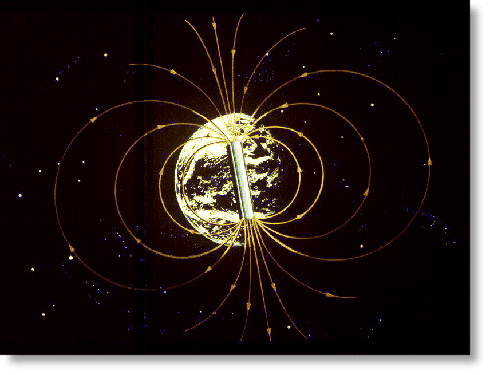
All magnetic objects produce invisible lines of force, extending between the poles of the object. Note that I said the lines were INVISIBLE. An easy way to see these invisible field lines is to spread iron filings on a sheet of paper and place a bar magnetic under the paper. The iron filings will arrange themselves around the magnet and along the magnetic field lines.
The earth acts like a very large magnet. Just as a bar magnet produces field lines, so too does Earth. And, just as the magnetic field of a bar magnet pushes iron filings into a pattern, so too does the Earth’s magnetic field. That is why a compass always points North. You can visualize the Earth’s invisible magnetic field lines by thinking of the Earth as having a bar magnet running from the North to South poles.
Magnetic fields also push things that have been charged by static electricity. Charged objects are objects that act like your hair when it sticks to the brush after you brush it. If these charged objects are moving in the magnetic field, they will be pushed by that field.
In the case of outer space, the charged objects pushed by the Earth’s magnetic field are ions and electrons. You may remember that ions are atoms that have had one or more electrons knocked off of them.
Our magnetic field is squashed by the solar wind.
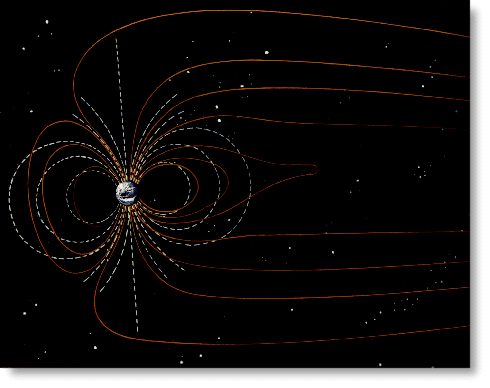
So the Earth has a magnetic field that reaches far out into space. And the magnetic field will push on charged particles that move in the field. But can it push on any old charged object that comes by? Well, only if the earth’s magnetic field is strong enough!
It just so happens the Sun sends more than light to the Earth. Besides light, the sun sends tiny, little pieces of matter to the Earth. These pieces of matter are moving very fast when they come close to the earth. In fact, they are moving so fast that scientists call this the SOLAR WIND.
The solar wind “squashes” the earth’s magnetic field. As can be seen in the picture above, the magnetic field lines on the sun side of earth (left) are squashed and on the side of the earth away from the sun (right), the magnetic field lines are stretched out as if the wind is trying to blow them away.
Earth’s magnetic field does a pretty good job of standing up to the solar wind. A great deal of the matter in the solar wind is pushed sideways around the earth by the earth’s magnetic field. The magnet of the earth pushes these particles sideways so they don’t hit the earth head on.
The Sun and the Earth are connected!
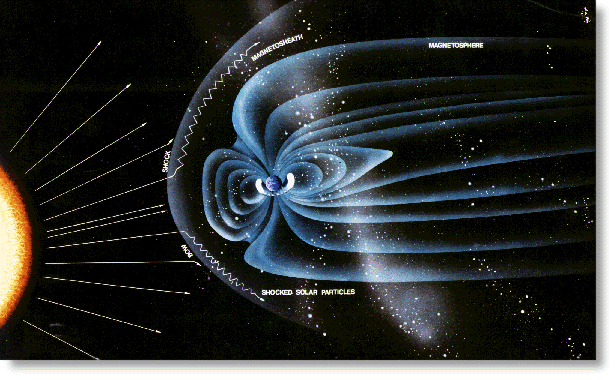
Earth is connected with our sun with more than light. In this picture, it appears the sun and earth are connected by the stream of charged particles that come from the sun. The Sun produces a hot gas that travels through space at a million miles per hour, carrying particles and magnetism outward past the planets. In essense, the Earth is immersed in the Sun’s atmosphere. Changes on the Sun affect the solar wind flow; for example, solar flares, which are explosions associated with sunspots, cause strong gusts of solar wind.
The space around the Earth’s atmosphere is alive and dynamic because the Earth’s magnetic field reacts to changes in the solar wind. The interaction between the solar wind and the plasma of the magnetosphere acts like an electric generator, creating electric fields deep inside the magnetosphere. These fields in turn give rise to a general circulation of the plasma within the magnetosphere and accelerate some electrons and ions to higher energies.
During periods of gusty solar wind, powerful magnetic storms in space near the Earth cause vivid auroras, radio and television static, power blackouts, navigation problems for ships and airplanes with magnetic compasses, and damage to satelites and spacecraft. Events on the Sun and in the magnetosphere can also trigger changes in the electrical and chemical properties of the atmosphere, the ozone layer, and high-altitude temperatures and wind patterns.
Solar wind would singe our atmosphere if not for our magnetic field.
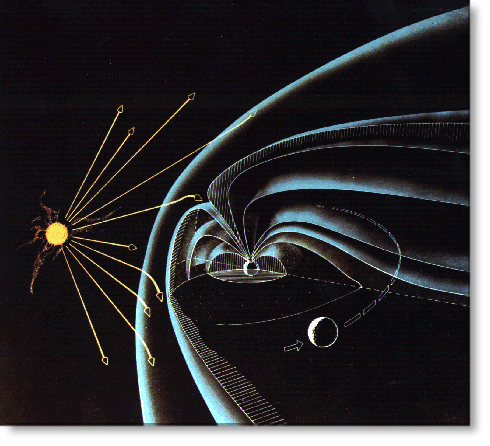
Solar wind travels past the Earth at well over 1,000,000 miles per hour. And thanks to the Earth’s magnetic field, the solar wind is stopped and deflected around the Earth so that most of it does not hit the earth’s atmosphere head on.
Ultra-violet rays from the sun ionize the upper atmosphere, creating the electrically-conducting ionosphere and a source of plasma for the magnetosphere. The energy from the solar wind enters the magnetosphere and is stored there, being released in sudden surges.
Mars, which has little or no magnetic field, is thought to have lost much of its former oceans and atmosphere to space. This loss was caused, at least in part, by the direct impact of the solar wind on Mars’ upper atmosphere. Earth’s other close planetary neighbor, Venus, has no appreciable magnetic field, either. Venus is also thought to have lost nearly all of its water to space, in large part owing to solar wind-powered ablation.
Scientists have drawn a map of the magnetosphere.
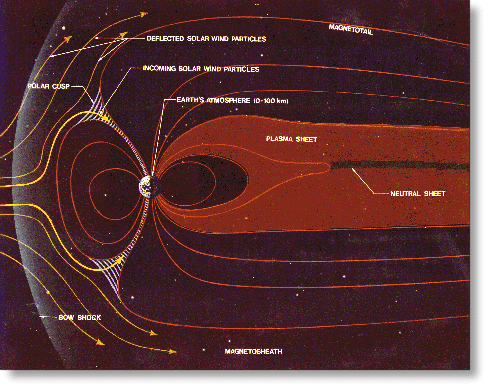
This picture shows a map of some of the major regions in the Earth’s magnetosphere.
When the solar wind comes to the earth it meets the Earth’s magnetic field. Most of the tiny particles in the solar wind are pushed around the earth because of this magnetic field. They begin their journey around in a curve called the “Bow Shock”. Just like water makes a curved wave in front of a boat, the solar wind makes a curve in front of the Earth. Afer passing through a shock wave at the bow shock, the wind flows around the magnetosphere and stretches it into a long tail. However, some solar wind particles leak through the magnetic barrier and are trapped inside. Solar wind particles also rush through funnel-like openings (cusps) at the North and South Poles, releasing tremendous energy when they hit the upper atmosphere. The Northern and Southern Lights (auroras) are the evidence we can see of this energy transfer from the Sun to the Earth.
The particles then follow a path that goes around the Earth in a sort of cover or sheath. This curve is called the “magnetosheath”. These particles mix with other particles that come up from the earth’s ionosphere to fill the magnetosphere.A great many of the tiny pieces of matter in the earth’s magnetosphere don’t come from the sun’s solar wind. They come from the earth. Earth can lift air particles into space and these particles will become charged by the time they get there.
The Earth’s atmosphere is protected from the solar wind by the magnetosphere. Even so, some solar wind energy does enter the magnetosphere and atmosphere and can cause a small amount of our atmosphere to be launched into space. It is important to understand this loss of atmosphere in order to understand Earth’s environmental stability over a long time period.
Solar wind energy in the magnetosphere can also cause what are known as space plasma storms. These storms can cause communication and science satellites to fail. They can also cause damage to electric power systems on the surface of the Earth.
A large space storm in 1989 made currents on the ground that caused a failure in the Hydro-Quebec electric power system. This prevented 6 million people in Canada and the US from having electricity for over 9 hours. The same storm caused the atmosphere to inflate and dragged the LDEF satellite to a lower orbit earlier than expected.

